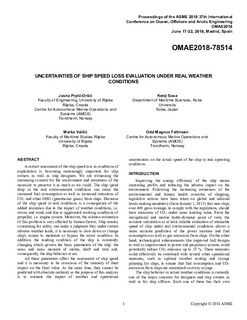Uncertainties of Ship Speed Loss Evaluation Under Real Weather Conditions
Chapter
Published version
Permanent lenke
http://hdl.handle.net/11250/2577957Utgivelsesdato
2018Metadata
Vis full innførselSamlinger
- Institutt for marin teknikk [3397]
- Publikasjoner fra CRIStin - NTNU [37221]
Originalversjon
10.1115/OMAE2018-78514Sammendrag
A correct assessment of the ship speed loss in conditions of exploitation is becoming increasingly important for ship owners as well as ship designers. We are witnessing the increasing concern for the environment and awareness of the necessity to preserve it as much as we could. The ship speed drop in the real environmental conditions can cause the increased fuel consumption as well as increased emissions of CO2 and other GHG (greenhouse gases) from ships. Decrease of the ship speed in real conditions is a consequence of the added resistance due to the impact of weather conditions, i.e. waves and wind, and due to aggravated working conditions of propeller, i.e. engine system. Moreover, the solution estimation of this problem is very affected by human factors. Ship master, concerning for safety, can make a judgment that, under certain adverse weather loads, it is necessary to slow down or change ship’s course to moderate or bypass the worst condition. In addition, the loading condition of the ship is constantly changing which govern the basic parameters of the ship: the mass and mass moment of inertia, draft and trim and, consequently, the ship behavior at sea.
All these parameters affect the assessment of ship speed and it is necessary to be conscious of the intensity of their impact on the final value. At the same time, they cannot be predicted with absolute certainty so the purpose of this analysis is to estimate the impact of weather and operational uncertainties on the actual speed of the ship in real operating conditions.
